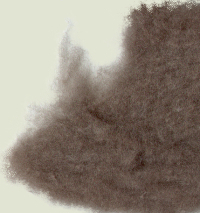Qiviut facts for kids
Qiviut (pronounced KIV-ee-uht) is a super soft and warm fiber. It comes from the inner wool of the muskox. The word "qiviut" is from the Inuit language. It can also mean any soft down, like bird feathers.
Muskoxen have two layers of fur. Qiviut is the soft, warm undercoat. It grows beneath their longer, tougher outer hair. Each spring, muskoxen naturally shed this inner wool.
People collect qiviut when the muskoxen shed it. They might pluck it from the animals. Sometimes, they gather it from bushes or rocks where the muskoxen have rubbed. Unlike sheep, muskoxen are never sheared. Most qiviut sold comes from Canada. It is often collected from muskoxen after hunts. In Alaska, qiviut comes from special farms or is gathered from wild animals during their shedding season.
Contents
Amazing Properties of Qiviut
Qiviut is known for being very special. It has some unique qualities that make it valuable.
Warmth and Softness
Qiviut is much warmer than regular sheep's wool. It is also softer than cashmere wool. This makes it one of the softest and warmest wools you can find. Wild muskoxen have qiviut fibers that are about 18 micrometers thick. That's super fine! Younger animals and females have even finer wool.
Unique Qualities
Unlike sheep's wool, qiviut does not shrink in water. This is true no matter how hot or cold the water is. However, this also means it cannot be used for felting. Felting is a process that uses heat and moisture to make fabric.
Qiviut is often used to make hats and scarves. These items are very expensive because qiviut is rare. A high-quality knitted scarf can cost over $300 U.S. dollars. But with good care, it can last for more than 20 years!
How Qiviut is Collected and Made
Collecting and preparing qiviut is a careful process. It ensures the fiber stays soft and strong.
Collecting the Fiber
An adult muskox can produce about 4 to 7 pounds of qiviut each year. The qiviut loosens from the animal's skin in the spring. It can look like the muskox is wearing "spectacles" around its eyes.
At research farms, special equipment is used. A modified "bison crush" gently holds the muskoxen. Then, workers use a long-toothed comb to remove the qiviut. It often comes off in one large piece. If not combed, the qiviut will fall off in clumps. This collected qiviut needs more cleaning.
Cleaning and Preparing Qiviut
After collection, the qiviut is cleaned by hand. Workers remove plants and other dirt. Then, it goes through a process called dehairing. This removes any coarser hairs that are thicker than 30 micrometers.
Dehairing is often done by carding. Carding is like brushing the fibers to align them. Mechanical carding can sometimes damage the qiviut. Because the fiber is combed, not shaved, very few coarse guard hairs are collected. However, qiviut from hunted animals is shaved. This means it needs more work to dehair. After dehairing, the qiviut is cleaned again if needed.
Spinning and Dyeing
The raw, clean qiviut is then spun into yarn. After spinning, the yarn is washed. Natural qiviut is a soft grayish-brown color. But it takes dye very well. You can find qiviut yarn in many different colors. Bleaching the fiber can weaken it. So, many people prefer overdyed natural qiviut. This gives the yarn darker, more muted colors.
History of Qiviut Production
The use of qiviut has a rich history, especially in Alaska.
Muskoxen in Alaska
Muskoxen were hunted to extinction in Alaska by the late 1800s. They were reintroduced in 1935. Soon after, an Alaskan home economics teacher began spinning qiviut herself. She gathered the fiber and made yarn.
Domestication and Cooperatives
Muskoxen were not domesticated until 1954. This began with the Musk Ox Project. It was led by John J. Teal, Jr. The first domestic muskox farm was in Fairbanks, Alaska. Today, the project continues at a muskox farm in Palmer, Alaska.
The Oomingmak Musk Ox Producer's Cooperative was formed in the late 1960s. It was started by Indigenous women on Nunivak Island. Dr. Teal and Mrs. L. Schell helped them. This cooperative focuses on knitting with qiviut. It is still active today. The cooperative's main office is in Anchorage, Alaska. It is owned by about 200 Native Alaskans from many different villages. The name "Oomingmak" comes from the Inuit word for muskox, which means "the animal with skin like a beard."
As of 2016, there were about four thousand muskoxen in Alaska. Raw qiviut fiber was sold for about $35 per ounce. This was roughly twice the price of cashmere. A scarf knitted by the Oomingmak collective cost about $275.
See also
 In Spanish: Qiviut para niños
In Spanish: Qiviut para niños


